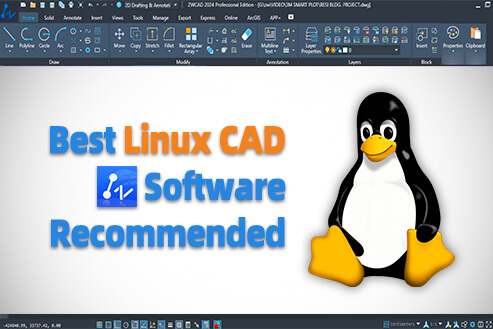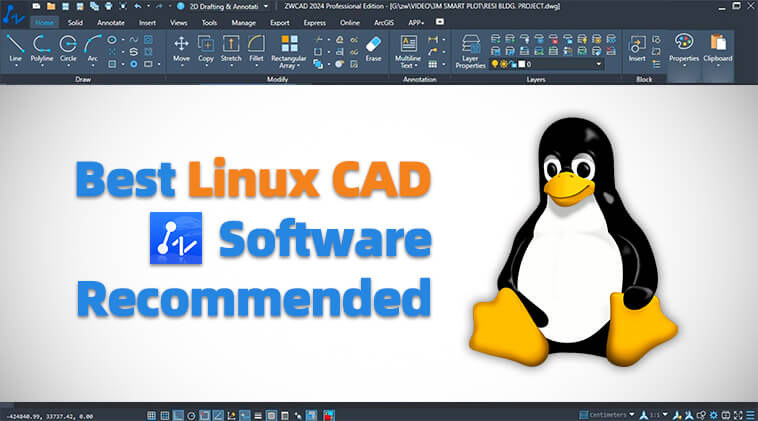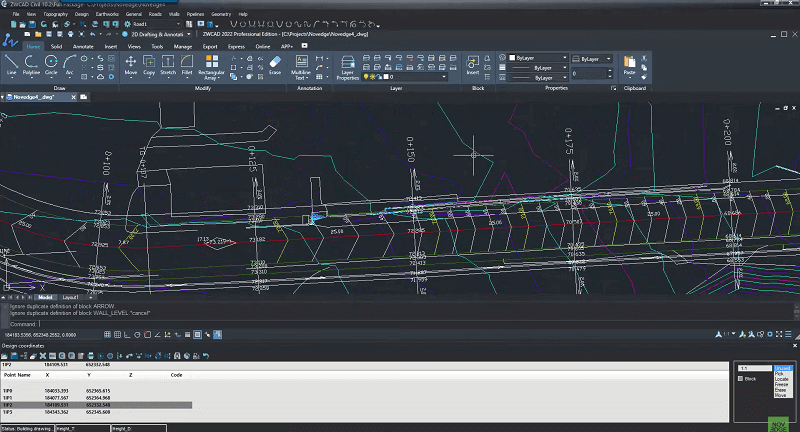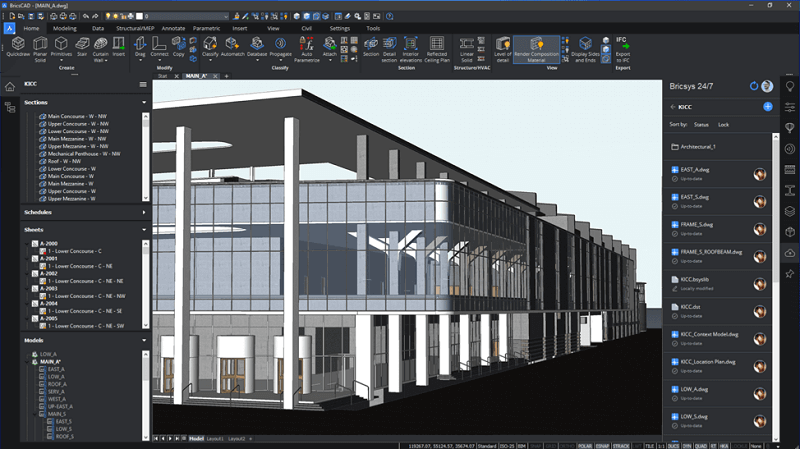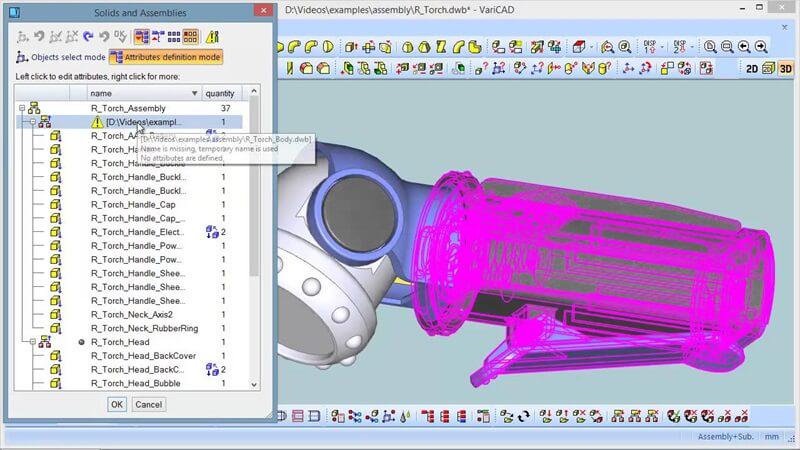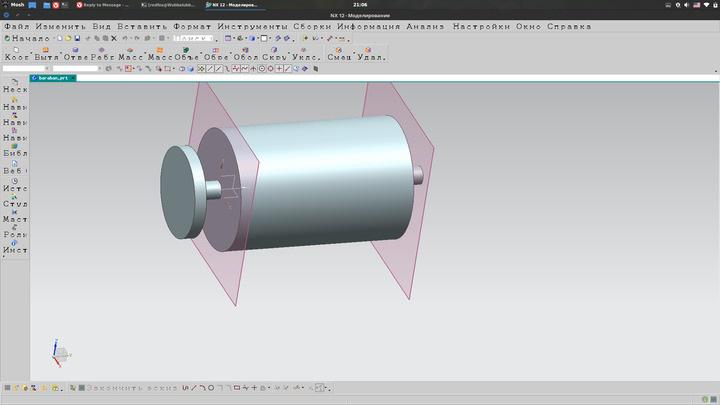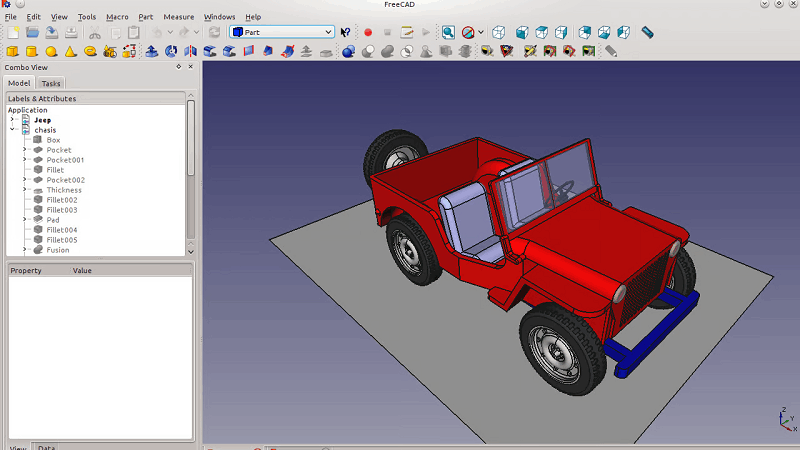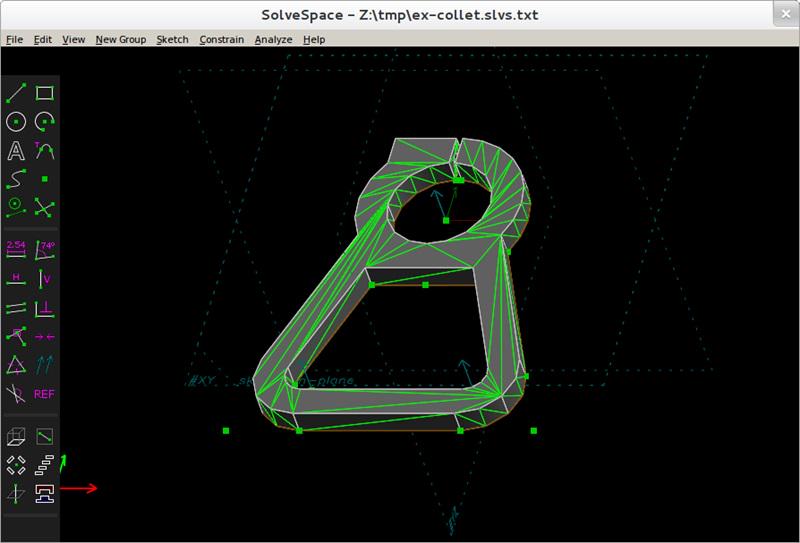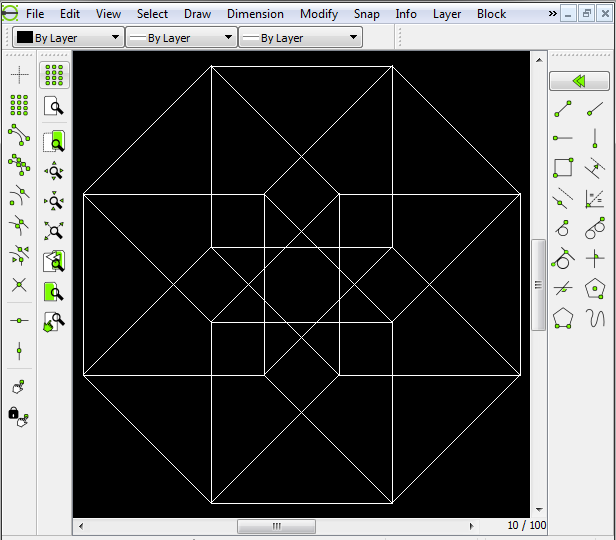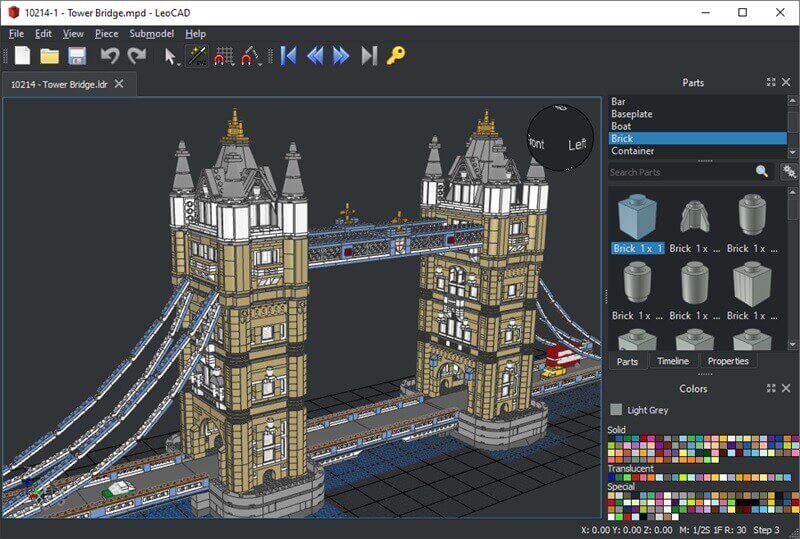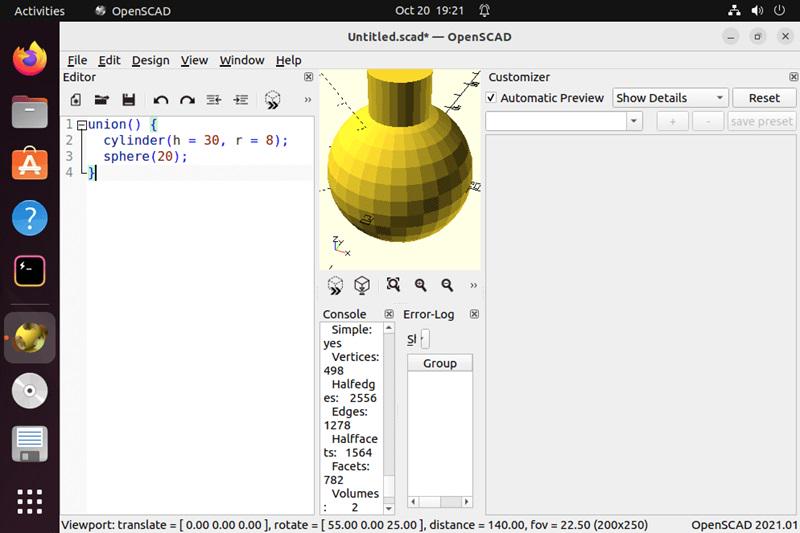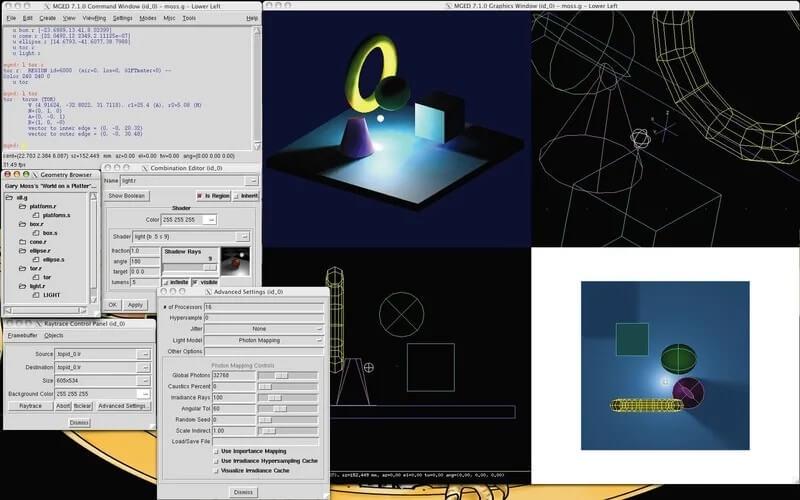Linux is a leading open-source operating system in terms of security, compatibility, and performance, even surpassing Windows and macOS in some areas. However, due to factors such as a smaller market share and differences in underlying libraries and APIs, the available Linux CAD software has been limited.
But fear not, a positive shift is underway. Open-source options and dedicated solutions provide more and more choices for CAD software for Linux. To make it easier for you, this post has compiled 10 of the best Linux CAD software. Some are paid, while others are entirely open-source and customizable. Without further ado, let’s jump in and make a selection based on the needs.
Contents
- 1. Why Use Linux for CAD?
- 2. What Should You Look for in Linux CAD Software?
- 3. 4 Best Paid Professional Linux CAD software (Free Trial Provided)
- 4. 6 Free Best CAD Software for Linux
- 5. An Overview of the 10 Linux CAD Software
- 6. Performance Optimization Tips for Running CAD on Linux
- 7. FAQs About Linux CAD Software
- 8. Conclusion
Why Use Linux for CAD?
There are several compelling reasons to use Linux as your CAD platform:
- Stability and performance: Linux systems are known for their long uptimes and minimal crashes, making them ideal for resource-intensive CAD applications.
- Security: Linux benefits from a strong security model, frequent updates, and a robust permission system. This reduces the risk of malware or unauthorized access.
- Cost-effectiveness: Most Linux distributions are completely free, and many high-quality CAD tools for Linux are open-source.
- Customization: Linux gives users deep control over their environment, CAD professionals can optimize their systems for performance and tailor user interfaces to their workflows.
For professionals seeking a lightweight, flexible, and secure environment for design work, Linux offers an attractive alternative to traditional operating systems.
What Should You Look for in Linux CAD Software?
Although Linux computers differ in appearance and operation from Windows and macOS, the criteria for good CAD software are still the same. Specifically, prioritize the following aspects such as comprehensive features, customization, collaboration, and security and stability.
- Ease of Use: Select Linux CAD software with a user-friendly interface for easy navigation and learning. It’s best if the commands and shortcuts bear minimal differences from other CAD software, making integration and transition more effortless.
- Abundance of Features: The ideal Linux CAD software should include both 2D drawing and 3D modeling, offer a vast model library, and support advanced features like rendering, simulation, and analysis.
- File Compatibility: It should be compatible with common CAD file formats such as DWG, DXF, DWT, and more, allowing smooth file opening, preview, and modification when collaborating with different teams.
- Feature Customization: Choose software that allows customization and extension through APIs to tailor design features for specific industries and specifications.
- Real-time Collaboration: Online file sharing and editing facilitates timely communication between multiple parties and can also improve the efficiency of design, so Linux CAD software that supports online collaboration is recommended.
- Stable Performance: A solid foundation for the best CAD software on Linux is stable performance. Therefore, before purchasing the software, it’s advisable to check the system requirements and related information on the official website to ensure your device can run smoothly.
- High security: Ensure that the 2D or 3D CAD software for Linux you download has permission control and appropriate security mechanisms to protect files and sensitive information from unauthorized access. Additionally, opt for tools that receive regular updates to prevent potential security bugs.
- Training Materials: Quality CAD software will provide user guides for different versions and operating systems, particularly for those with a steeper learning curve. If you cannot find resources through official channels, software with relevant information on third-party platforms is also a good choice.
4 Best Paid Professional Linux CAD software (Free Trial Provided)
For ease of selection, the 10 best CAD software for Linux are divided into two parts: paid and free. Although the four options in this part are all paid, they are more stable in performance and can be converted between 2D and 3D designs in the software at will. Therefore, this is a must-see list for professional practitioners and students.
Top 1. ZWCAD
Best for: Beginners and professionals in architecture, civil engineering, mechanical engineering, landscape design, and GIS
Pricing: Currently ZWCAD Linux is officially available only in the Chinese market, with no dedicated versions offered overseas.
Note:
ZWSOFT has released ZWCAD Flex, a subscription-based CAD solution currently available exclusively in the United States and Canada.
Users outside these regions are encouraged to contact their local ZWSOFT sales team to explore perpetual license options for ZWCAD.
ZWCAD is a powerful CAD solution known for full DWG compatibility and robust features such as 2D drafting, 3D modeling, rendering, and analysis, its availability outside China is limited. The software supports extensive customization through APIs and integrates with over 200 third-party design applications, making it suitable for professionals in architecture, engineering, and manufacturing.
ZWCAD maintains a user-friendly interface with smart workflow features like mouse gestures, voice commands, and a File Compare tool to quickly identify differences between drawings. Although it is not currently optimized for Linux, users interested for a Linux version of ZWCAD can contact sales (sales@zwsoft.com) to see whether there are alternative solutions available that can meet your requirements.
Pros
- Powerful design and modeling features;
- Compatible with common CAD file formats like DWG, DXF, and DWT;
- Achieve feature customization through APIs like LISP, VBA, ZRX, and .NET;
- Allow design file sharing and editing for online collaboration;
- Works stably and quickly even when dealing with large files;
- Offer a one-time purchase subscription plan with no additional fees;
Cons
- Doesn’t provide an oversea version.
Top 2. BricsCAD
Best for: Architecture, engineering, manufacturing, and product design.
Pricing: Lite version starts at $708/lifetime and $314/year.
As the best 2D CAD software for Linux, BricsCAD has a full set of drawing tools and supports creating multiple layouts with different scales and viewports for complex drawings. In 3D, it can create the required models through direct editing, parametric modeling, solid modeling, and mesh modeling, and complete realistic rendering and visualization. It is worth mentioning that dynamic rendering results are also feasible in BricsCAD.
Beyond that, BricsCAD can use LISP and DIESEL scripts to automate repetitive tasks. It is also connected to various cloud storage services such as Dropbox and Google Drive for easy file sharing and collaboration. In the latest V24 version, compatibility with BIM software and AutoCAD files is strengthened. Meanwhile, it improves memory management and adds multi-core support. This ensures that large and complex drawings can be completed stably and quickly.
Pros
- Natively designed for Linux with reliable performance;
- Provide diverse modeling options for complex models;
- Compatible with DWG format to make AutoCAD integration easy;
- Take advantage of multi-core processors to allocate workloads;
- Offers a 30-day free trial for testing.
Cons
- Customer support needs improvement;
- Third-party applications are limited compared to other software;
- The forum doesn’t have many active users.
Top 3. VariCAD
Best for: Mechanical engineering
Pricing: VariCAD for Linux license, including One Year Upgrade is $1150
With a vast part library that meets ANSI, DIN, and JIS standards, VariCAD is great mechanical CAD software on Linux. It can build complex 3D models using solid graphics, adjust surface curvature through surface design, and combine and modify solid models using Boolean operations. And as one of the best 3D CAD software for Linux, VariCAD can check for possible collisions between components in 3D assemblies, making the design accuracy and feasibility more intuitive.
In addition, VariCAD is also 2D CAD software for Linux. It can directly use tools for mechanical drafting. Alternatively, by defining 3D views, it produces traditional engineering drawings that can interact with other CAD software. Common 2D compatible formats for VariCAD include DWG, DXF, and STEP (import support).
Pros
- Easy to navigate with a clear interface;
- Exchange files with other CAD systems using diverse 2D and 3D formats;
- Calculate values such as 2D cross-sectional area, surface area, and volume;
- Support assembly design and allow rendering and testing of 3D models;
- Built-in BOM and Title Blocks with the ability for batch modification.
Cons
- Lacks support for collaborative work;
- Not suitable for electrical design and structural engineering.
Top 4. Siemens NX
Best for: Mechanical engineering and product design
Pricing: Not provided by the vendor, but can be expensive for yearly subscriptions.
Siemens NX is another CAD software for Linux that supports both 2D and 3D. It offers a robust sketching environment with a complete set of line and shape tools. And it boasts a parametric design. Thus, modifications can be easily made by changing constraint and dimension values without repeated drawings. Its 3D design is also very practical, along with a variety of modeling methods such as direct modeling, feature modeling, and assembly modeling.
However, the most noteworthy point is that it supports generative design. This feature can automatically generate design options based on your input standards. It is a great way to spark design inspiration and find the best solution. Moreover, Siemens NX allows simulation analysis of physical aspects such as stress and thermal behavior, ensuring designs meet requirements and standards.
Pros
- Possess CAD, CAM, and CAE capabilities at the same time;
- Features different simulation tools to test designs;
- Customize software features with extensive scripts and APIs;
- Integrate with Teamcenter PLM for efficient data management and collaboration;
- Offers an online community and numerous tutorials.
Cons
- The UI isn’t very user-friendly;
- It utilizes symbols, expressions, or parameters to define tolerances in the design;
- There are some features that are hard to understand and somewhat redundant.
6 Free Best CAD Software for Linux
Now, let’s move on to free Linux CAD software. Most of them are open source, and as a result, some options are still under development. But if you’re a beginner, just need basic design features, or prefer open-source software for customization, these are your best choices.
Top 5. FreeCAD
Best for: Architecture, mechanical engineering, product design, and education
Open-source: Yes
FreeCAD is open-source, free CAD software for Linux. It can do 2D design, but its 3D parametric modeling is practical for mechanical parts, product design, etc. Models can be modified based on properties such as values, text, on/off buttons, or even other objects. With a feature tree and history, this beginner-friendly CAD software allows for non-destructive modification and regeneration of features. What’s more, it integrates finite element analysis. This can help you study the stress, strain, and deformation of the model.
Even better, FreeCAD boasts a large and growing multi-professional ecosystem. Its core functionality is coded in C++, but the user interface and basic design functionality are coded in Python. This allows a large number of users to continuously expand its functionality. Originally focused on mechanical engineering, it now has CSG modeling, BIM modeling, and 3D printing for other industry needs.
Pros
- It’s lighter than similar software of its kind.
- Compatible with dozens of different CAD file formats;
- Offer an extensive parametric design environment;
- Provide community support and related training materials;
- Customize unique design features using Python scripts.
Cons
- Lacks basic analysis tools;
- It doesn’t support 3D rendering capabilities;
- Limited functionality tools, which can be restrictive when dealing with complex CAD files.
Top 6. SOLVESPACE
Best for: Mechanical engineering, 3D printing, and education
Open-source: Yes
SolveSpace is free CAD software for Linux. It can create 3D constructs using CSG (constructive solid geometry) modeling by combining basic shapes and using stretching, rotation, and Boolean operations. Meanwhile, the software features mechanical simulation to test the functionality and strength of models under simple loads and constraints. If you prefer 2D design using SolveSpace, it’s well-equipped for that too. One of the best is the ability to create multiple working planes for complex 2D geometric shapes and projecting 3D features.
SolveSpace is also open-source, so you can use Python scripting to automate tasks or customize design tools. Better yet, SolveSpace is extensible and modifiable, and its source code is available on GitHub. This turns it into not just design software but also a valuable educational tool.
Pros
- Easy to get started with a user-friendly interface;
- Support various 2D and 3D output formats, including DXF, EPS, PDF, etc;
- Enable the creation of multiple components for assembly modeling;
- Feature constraints and dimensions for precise control and documentation;
- Accessible source code for extending and developing its features.
Cons
- The feature tree doesn’t have a separate window; you need to keep clicking “Home” to return;
- Does not support hiding or suppressing specific design features or elements;
- It runs slowly with a large number of constraints.
Top 7. LibreCAD
Best for: Architecture, engineering, manufacturing, and graphic design
Open-source: Yes
Looking for dedicated 2D Linux CAD software? Then you must give LibreCAD a try. It comes with a variety of line styles, hatching, and patterns. Constraints can also be employed to maintain specific relationships between geometric entities, ensuring accuracy and consistency. To streamline design, commands like trim, extend, offset, and mirror allow quick modifications to existing design elements in LibreCAD. It also permits the creation of reusable symbols and blocks to represent common components for high efficiency.
However, the most notable feature of this top free 2D CAD software is that it is open-source. In this scenario, it benefits from a vibrant community of developers and users offering support resources. More importantly, it allows you to extend LibreCAD’s features using Python scripts. Thus, repetitive tasks can be automated and the software can be customized based on your specific needs.
Pros
- Free and easy to use with no extra fee;
- Personalize the interface, shortcuts, and settings for your preferences;
- Import and export a range of files like BMP, CUP, ICO, and more;
- Support 8 dimensioning types and 3 dimension units.
Cons
- Limited functionality leads to some restrictions during design;
- Poor performance, resulting in delays when handling complex and large files;
- It does not support 3D.
Top 8. LeoCAD
Best for: Design, education, entertainment and media
Open-source: No
Unlike traditional parametric and direct modeling software, LeoCAD has a full library of LEGO bricks, minifigs, and other elements. This means it can easily apply these preset shapes to solid 3D objects. And to make designs accurate, this best 3D CAD Linux software can use snapping, grids, and numerical input to align bricks and place pixels. Even better, designs can be set up as manageable steps for easy sharing and collaboration with others.
LeoCAD’s rendering capabilities are also no slouch. There are two rendering methods available to you: internal rendering and external rendering. The internal renderer will use a variety of lighting, shadowing, and reflection options to create realistic images and animations for your models. External rendering involves exporting 3D models to design software like Blender for more advanced operations. Additionally, this Linux CAD Software comes with a built-in physics simulator to test the stability and motion of models, particularly useful for mechanical devices and vehicles.
Pros
- Free and user-friendly modeling as playing with LEGO;
- Offer multiple modeling views for complete control and precision;
- Customize parts and textures to extend creativity;
- Achieve automated repetitive tasks and feature customization with scripts;
- Integrate with other LEGO software and the community through LDraw files.
Cons
- Runs unstable and sometimes crashes;
- Low maintenance frequency and may make files prone to viruses.
Top 9. OpenSCAD
Best for: Mechanical engineering, prototype design, and art design
Open-source: No
Although OpenSCAD is free, it may have a learning curve. Because it creates solid 3D objects using a scripting language. By modifying the variables and expressions defined in the code, models will adjust the dimensions, shapes, and curves, etc. This precision is particularly useful for adjusting clearances between mechanical components. Meanwhile, OpenSCAD provides a variety of functions to help you operate and transform 3D shapes to create complex solid objects.
Not only that, the code writing and 3D model construction are displayed on the same screen, which makes it easy for you to preview and modify at any time. OpenSCAD also offers options for custom rendering and visualization. Lighting, materials, textures, and even creating custom shaders to enhance the visual appearance of your design are all possible within the Linux CAD software. Furthermore, model drawings and rendered images can be exported in common formats for sharing or 3D printing.
Pros
- Parametrically modify constructive solid geometry with scripts;
- Customize models and functions to assist in complex designs and operations;
- Able to integrate into open-source design software like FreeCAD.
Cons
- The CAD interface isn’t intuitive enough for 3D modeling;
- It’s more cumbersome to create complex shapes in 3D models because there are no smooth transitions;
- Various limitations make it more time-consuming to work with.
Top 10. BRL-CAD
Best for: Architecture, civil engineering, mechanical engineering, and product design
Open-source: Yes
The last Linux CAD software to recommend is BRL-CAD. It’s free and allows for the creation of 3D solid models using simple shapes. Additionally, it provides advanced tools for fine-tuning models. This means that you can complete tasks such as surface carving, chamfers and fillets adding, or curvature or thickness analysis in one software. Better still, its open-source nature allows you to write scripts to customize features, automate repetitive designs, and generate complex shapes and patterns through algorithms.
BRL-CAD is also good at rendering. With its powerful ray tracing engine, models can be rendered with realistic quality to create stunning visuals for presentations, simulations, and even films. If your model is of a large scale, BRL-CAD has you covered as well. It can distribute rendering workloads across a computer network to speed up the time it takes to display the final image. However, the most impressive thing about BRL-CAD is that it has image and signal processing tools for tasks such as medical image analysis, radar data processing, and even computer vision applications.
Pros
- Support both shape modeling and procedural modeling;
- Feature two different rendering modes to produce high-quality images;
- Customize software through code according to preferences;
- Applicable in professional fields such as medicine as a 3D design tool;
- Provide comprehensive community and training material support.
Cons
- Adding standard design features such as fillets is rather difficult;
- Not user-friendly for model design;
- Cannot achieve smooth organic shapes, such as sweep or loft;
- Does not support surfaces and rendering.
An Overview of the 10 Linux CAD Software
Wise choices cannot be made without more intuitive comparisons. Therefore, a comparison table has been created below. Combining these key points with the descriptions above can guide you in selecting the Linux CAD software that best suits your needs.
| Best For | Design Type | Compatible Formats | Open-Source | Feature Customization | Learning Tutorials | Performance | Pricing | |
| ZWCAD | Beginners and designers | 2D & 3D | DWG, DXF, DWT, SAT, etc. | No | √ | √ | CPU and GPU acceleration | Available only in the Chinese market |
| BricsCAD | Designers | 2D & 3D | BMP, DXF, DWT, FBX, etc. | No | √ | √ | Normal | $314/year (2D only);$711/year (2D & 3D) |
| VariCAD | Designers | 2D & 3D | DWG, DXF, STEP, STL, etc. | No | √ | √ | Normal | $1150/year |
| Siemens NX | Designers | 2D & 3D | JT, IGES, DXF, DWG, etc. | No | √ | √ | Normal | Expensive with flexible pricing, contact sales for negotiations |
| FreeCAD | Beginners and designers | 2D & 3D | STEP, IGES, OBJ, STL, DWG, etc. | Yes | √ | √ | Normal | Free |
| SOLVESPACE | Beginners and designers | 2D & 3D | DXF, EPS, PDF, STEP, etc. | Yes | √ | √ | Normal | Free |
| LibreCAD | Beginners and designers | 2D | CUR, JPG, BMP, ICO, etc. | Yes | √ | √ | Normal | Free |
| LeoCAD | Beginners and designers | 3D | LDR, MPD, DAT, etc. | No | √ | √ | Normal | Free |
| OpenSCAD | Designers | 3D | DXF, SVG, PNG, STL, etc. | No | √ | √ | Normal | Free |
| BRL-CAD | Designers | 3D | STL, DXF, Pro/E, OBJ, etc. | Yes | √ | √ | Normal | Free |
The best Linux CAD software for you will depend on your specific needs and experience level. If you are a beginner, LibreCAD or LeoCAD are good options. However, ZWCAD remains the top recommendation. It supports both 2D and 3D, offers customizable features, and has a free version for trial. For those with more experience, BricsCAD, VariCAD, FreeCAD, and others are preferable. Despite steeper learning curves, they boast advanced features and greater flexibility, making them suitable for various industries and purposes.
Performance Optimization Tips for Running CAD on Linux
Enable Hardware Acceleration
Make sure the CAD software has GPU hardware acceleration enabled to improve rendering speed and graphics performance.
Reduce Interface and Feature Load
Disable unnecessary plugins, toolbars, and views to reduce memory and CPU usage, speeding up startup and operation. Also, turn off rarely used display options, such as disabling fill display during zoom, to lessen rendering load.
Use Layers and Object Snapping Wisely
In complex drawings, turn off or lock unnecessary layers to reduce computational and display pressure. Enable only commonly used object snapping options to avoid performance degradation caused by enabling all snapping features.
Adjust Display and Save Settings
Set appropriate crosshair and snap marker sizes to enhance smooth operation. Avoid very short auto-save intervals to prevent performance slowdowns. Use file formats compatible with your CAD software to reduce overhead from version conflicts.
FAQs About Linux CAD Software
Can I run AutoCAD on Linux?
AutoCAD is not officially available for Linux systems, but it may run through Wine or a virtual machine. As an alternative, ZWCAD offers robust DWG compatibility and serves as an excellent replacement for Linux users.
Is It Easy to Learn and Use Linux CAD Software?
Linux CAD software is similar to CAD software on Windows and Mac. It has 2D, 3D, and some advanced features. As long as you are willing to put in the time and effort, it is not difficult to master, just a matter of time. if you are a complete beginner to CAD software for Linux, it is recommended that you start with easy-to-use software with many tutorials, such as ZWCAD and FreeCAD. They help with your confidence and foundation. As you gain proficiency, you can explore other more challenging open-source design software to improve your skills.
Is There Linux CAD Software for 3D Printing?
Certainly, there is a lot of Linux CAD software for 3D printing. Choices like ZWCAD, BricsCAD, and LeoCAD in the article all provide powerful 3D modeling tools and can export models to 3D printer-compatible file formats such as STL, FBX, and OBJ. In addition, Blender, Wings 3D, and Onshape (web-based) are also additional options that can be used for 3D printing.
Can You Use Browser-Based CAD Software on Linux?
Yes, there are some online CAD tools you can use on Linux as long as your browser is compatible with them, such as SketchUp Free and Onshape.
However, it is important to note that online and open-source 2D and 3D CAD software for Linux are more suitable for beginners and small objects. Also, they may be unavailable due to untimely technical support.
Conclusion
This 10 best Linux CAD software each have their own advantages, and can meet the needs of beginners and professionals to handle designs on Linux. Overall, ZWCAD is the best option because of its great features and cost-effectiveness. With this tool as a strong backing, you are ensured to cope with various design challenges on Linux.
.png)
